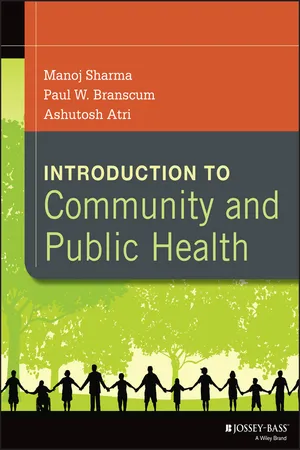
- English
- ePUB (mobile friendly)
- Available on iOS & Android
Introduction to Community and Public Health
About this book
Introduction to Community and Public Health covers the basics in each area of community and public health as identified by the Association of Schools of Public Health. In a student-friendly approach, authors Manoj Sharma, Paul W. Branscum, and Ashutosh Atri discuss epidemiology, biostatistics, social and behavioral sciences, environmental health, and healthy policy and management. Written to serve both graduate and undergraduate public health students, as well as to help prepare for the Certified in Public Health (CPH) exam, Certified Health Education Specialist (CHES) exam and Master certified in Health Education Specialist (MCHES) exam, the book covers each of these five core disciplines, plus other important topics such as:
- Population dynamics and control
- Air, water, and noise pollution, and other environmental issues
- Program planning, budgeting, management, and evaluation
- Systems thinking and leadership in community and public health
Students will gain insight into the descriptive, inferential, and analytical aspects of community and public health, as well as models, methods, and theories in health education and health promotion. Introduction to Community and Public Health provides the foundation necessary to build the skills of tomorrow's community and public health leaders.
Frequently asked questions
- Essential is ideal for learners and professionals who enjoy exploring a wide range of subjects. Access the Essential Library with 800,000+ trusted titles and best-sellers across business, personal growth, and the humanities. Includes unlimited reading time and Standard Read Aloud voice.
- Complete: Perfect for advanced learners and researchers needing full, unrestricted access. Unlock 1.4M+ books across hundreds of subjects, including academic and specialized titles. The Complete Plan also includes advanced features like Premium Read Aloud and Research Assistant.
Please note we cannot support devices running on iOS 13 and Android 7 or earlier. Learn more about using the app.
Information
Chapter 1
Introduction to Community and Public Health
Learning Objectives
- Define basic terms in community and public health.
- Differentiate between medicine and community and public health.
- Identify issues in community and public health.
- Identify and classify factors affecting community and public health.
- Describe local, state, national, and global organizations in community and public health.
- Trace the historical timeline of community and public health.
- Explain the current challenges confronting community and public health.
Defining Community and Public Health
health

community
Table of contents
- Cover
- Title Page
- Copyright
- Dedication
- Figures and Tables
- Preface
- Acknowledgments
- The Authors
- Chapter 1: Introduction to Community and Public Health
- Chapter 2: Descriptive Epidemiology in Community and Public Health
- Chapter 3: Analytical Epidemiology in Community and Public Health
- Chapter 4: Descriptive Biostatistics in Community and Public Health
- Chapter 5: Inferential Biostatistics in Community and Public Health
- Chapter 6: Social and Behavioral Sciences in Community and Public Health
- Chapter 7: Models in Health Education and Health Promotion
- Chapter 8: Theories in Health Education and Health Promotion
- Chapter 9: Methods in Health Education and Health Promotion
- Chapter 10: Population Dynamics and Control
- Chapter 11: Air, Water, and Noise Pollution
- Chapter 12: Injury Control and Other Environmental Issues
- Chapter 13: Organization, Financing, and Delivery of Health Services and Public Health Systems in the United States
- Chapter 14: Program Planning, Budgeting, Management, and Evaluation in Community Initiatives
- Chapter 15: Systems Thinking and Leadership in Community and Public Health
- Glossary
- Index
- End User License Agreement